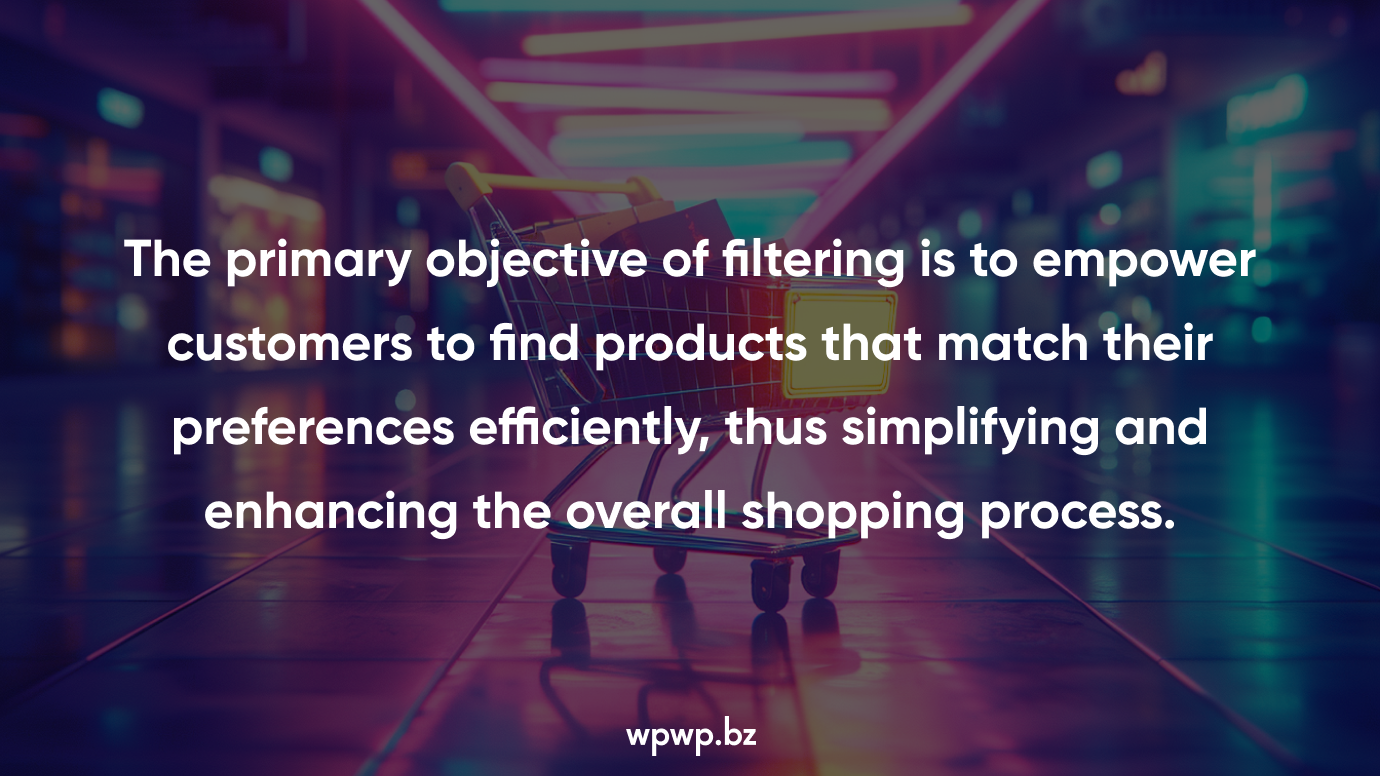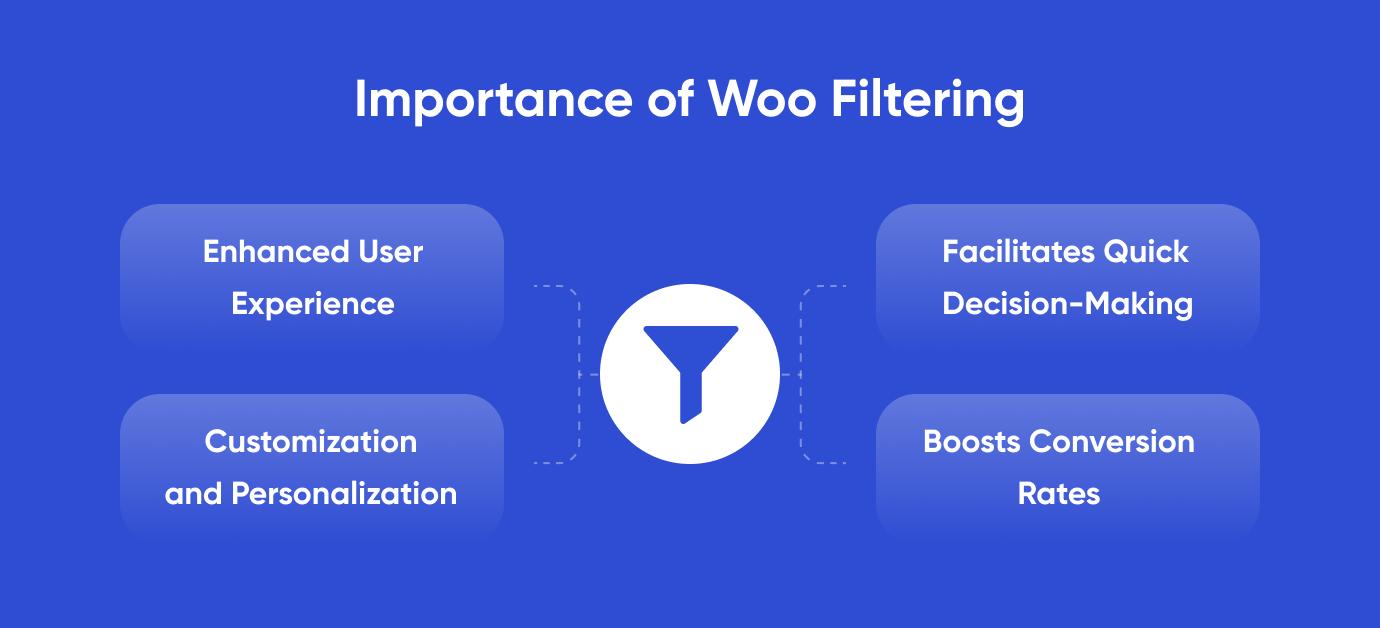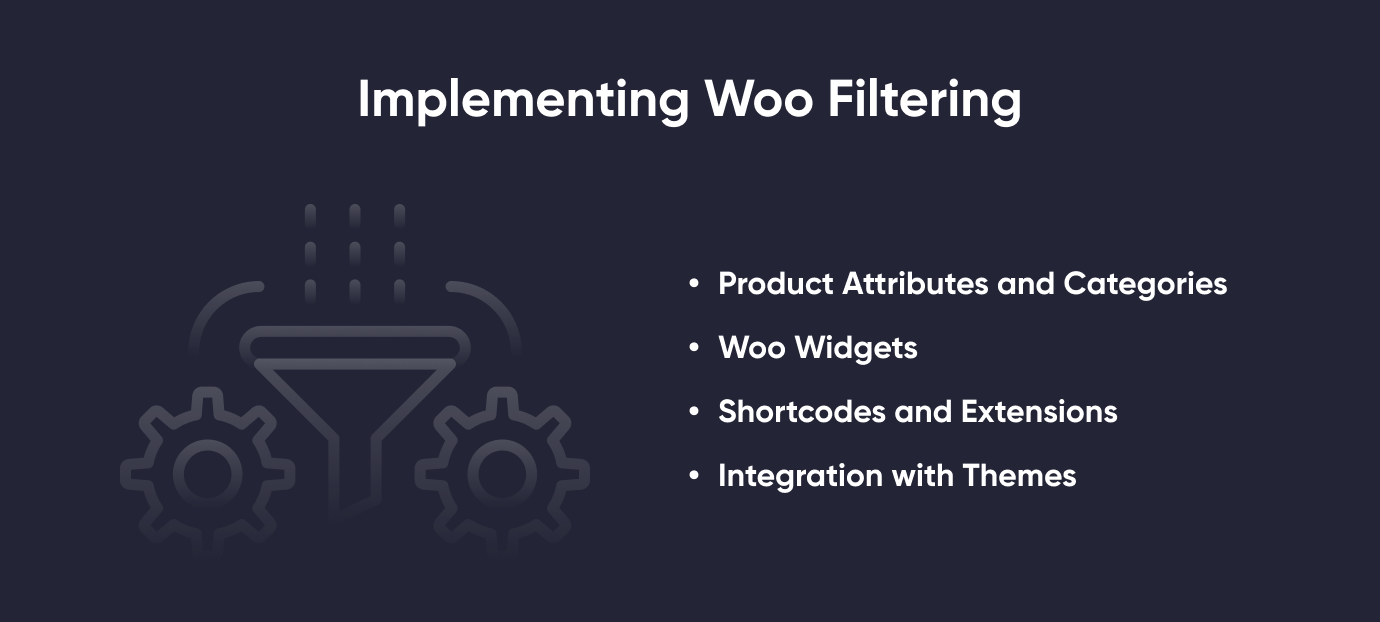Defining Woo Filtering
Woo filtering can be defined as the process through which online store visitors refine their product searches based on specific criteria or attributes. These criteria typically include product categories, price ranges, sizes, colors, and other relevant characteristics that define a product.

Importance of Woo Filtering

- Enhanced User Experience. One of the primary advantages of Woo filtering is its significant contribution to improving the overall user experience on an e-commerce website. By allowing customers to narrow down their choices based on specific parameters, filtering saves time and enhances customer satisfaction, fostering a positive perception of the online store.
- Facilitates Quick Decision-Making. In the vast online marketplace, the abundance of choices can overwhelm customers. Woo filtering empowers users to make quicker and more informed decisions by enabling them to focus on the exact products that meet their requirements. This efficiency is crucial in positively influencing purchasing decisions.
- Customization and Personalization. Every customer is unique, with preferences that vary widely. Woo filtering allows online store owners to offer a personalized shopping experience by providing a range of filter options that align with diverse customer needs. This customization adds a layer of personalization, making the shopping experience more engaging and tailored to individual preferences.
- Boosts Conversion Rates. The correlation between user experience and conversion rates is well-established. Woo filtering contributes to a more pleasant and efficient shopping journey by simplifying the product discovery process. This positive experience often translates into higher conversion rates, as customers are more likely to complete transactions when the process is smooth and tailored to their needs.
Core Components of Woo Filtering
Product Attributes and Categories
The foundation of Woo filtering lies in defining and assigning attributes and categories to products. These could include size, color, brand, price range, and more. Organizing products into meaningful categories and specifying attributes lays the groundwork for effective filtering.
Woo Widgets
Widgets are powerful tools within Woo for implementing filtering options. The plugin provides a variety of widgets that can be easily added to different sections of the website, such as the sidebar or product pages. These widgets include categories, price filters, attribute filters, and more, offering a seamless integration with the overall design of the online store.
Shortcodes and Extensions
For more advanced filtering capabilities, shortcodes and extensions come into play. Shortcodes allow users to embed specific features or functionalities directly into pages or posts, providing a more tailored and customized approach to filtering. Extensions, on the other hand, offer additional features beyond the default Woo settings, enhancing the filtering capabilities of the online store.
Integration with Themes
Many WordPress themes are designed to seamlessly integrate with Woo, providing a cohesive and visually appealing interface for customers. These themes often include predefined styles for Woo filtering elements, ensuring a consistent and attractive design across the website. The integration with themes is crucial for maintaining a seamless user experience and ensuring that filtering elements align with the overall aesthetics of the online store.
Implementing Woo Filtering

- Product Attributes and Categories
- Attribute Creation. Start by creating product attributes that define the key characteristics of your products. These attributes could include size, color, material, and any other relevant features. Woo allows for the creation of both global and product-specific attributes, providing flexibility in organizing and categorizing products.
- Assigning Attributes to Products. Once attributes are created, assign them to individual products. This step ensures that each product is associated with the appropriate attributes, making it easier for customers to filter and find products based on their preferences.
- Category Organization. Categories provide a broader classification of products. Organize products into logical categories to facilitate a structured browsing experience. Categories can be hierarchical, allowing for a more granular organization of products within the online store.
- Woo Widgets
- Category Widget. The category widget is a fundamental tool for implementing filtering options. It allows customers to filter products based on specific categories, enabling them to narrow down their choices quickly. The widget is often placed in the sidebar, providing easy access during the browsing process.
- Price Filter Widget. Price is a critical factor in purchasing decisions. The price filter widget enables customers to set a specific price range, refining their search based on budget constraints. This widget contributes to a transparent and user-friendly pricing experience.
- Attribute Filter Widget. Attribute filter widgets cater to more specific product characteristics. Whether it’s filtering by color, size, or any other attribute, these widgets provide a dynamic and interactive way for customers to customize their product searches.
- Product Search Widget. The product search widget complements filtering options by allowing customers to enter keywords and search for specific products. This widget is particularly useful for customers who have a clear idea of what they are looking for and want to bypass the browsing process.
- Shortcodes and Extensions
- Shortcodes for Customization. Shortcodes offer a high level of customization by allowing users to embed specific features directly into pages or posts. Woo provides various shortcodes for implementing filtering options, and users can tailor them to fit the design and layout of their online store.
- Extensions for Advanced Functionality. Extensions enhance the default capabilities of Woo, providing advanced features for filtering. These could include dynamic filtering, AJAX-based filtering (allowing filtering without page reloads), and additional layout options. Popular extensions like Woo Product Filter and YITH Woo Ajax Product Filter offer a wide range of functionalities to meet diverse filtering needs.
- Implementing Shortcodes and Extensions. Implementing shortcodes involves inserting them into the desired locations within your WordPress content. Extensions, on the other hand, require installation and activation through the WordPress dashboard. Once activated, extensions often provide additional settings and customization options that can be configured to align with the specific requirements of the online store.
- Integration with Themes
- Choosing a Woo-Compatible Theme. The choice of a theme is crucial for a seamless integration of Woo filtering elements. When selecting a theme, ensure that it is explicitly designed to be compatible with Woo. Many premium and free themes offer dedicated styling for Woo, ensuring that filtering elements blend seamlessly with the overall design.
- Customization Options. Themes often come with customization options that allow users to tweak the appearance of Woo elements. This includes styling options for buttons, filters, and product grids. Utilize these customization options to ensure that filtering elements align with the visual identity of the online store.
- Testing for Responsiveness. With the increasing prevalence of mobile shopping, it’s imperative to ensure that Woo filtering elements are responsive and function seamlessly across various devices. Test the filtering options on different screen sizes to guarantee a consistent and user-friendly experience for customers accessing the online store from smartphones and tablets.
Impact of Woo Filtering on Online Store Success
Customer Retention
A positive shopping experience, facilitated by effective Woo filtering, significantly contributes to customer satisfaction and retention. When customers find products quickly and effortlessly, they are more likely to return to the online store for future purchases. The convenience offered by filtering options fosters a sense of loyalty among customers, solidifying the online store’s position in their shopping preferences.
Competitive Advantage
In a saturated e-commerce landscape, standing out from the competition is essential. Online stores that invest in and optimize Woo filtering gain a competitive edge by providing a superior user experience. The ability to quickly and accurately meet customer needs sets these stores apart, attracting and retaining customers in a fiercely competitive market.
Reduced Bounce Rates
Bounce rates, indicating the percentage of visitors who leave a website without further interaction, are significantly influenced by the efficiency of filtering options. When customers can quickly find what they are looking for, they are less likely to abandon the site. Effective Woo filtering contributes to lower bounce rates, indicating a higher level of engagement and satisfaction among visitors.
Data-Driven Insights
Woo filtering generates valuable data that can be harnessed for strategic decision-making. By analyzing the data derived from filtering options, online store owners gain insights into customer behavior, preferences, and trends. This data-driven approach allows for informed decisions regarding inventory management, marketing strategies, and product offerings, ultimately optimizing the business for sustained success.
Future Trends in Woo Filtering
As e-commerce continues to evolve, several trends are shaping the future of Woo filtering:
- AI-Powered Personalization. Integrating artificial intelligence (AI) into Woo filtering enables advanced personalization. AI algorithms can analyze customer behavior, preferences, and purchase history to dynamically adjust filtering options, providing an even more tailored shopping experience.
- Voice-Activated Filtering. With the rise of voice-activated technologies, incorporating voice-activated filtering options into Woo could become a prevalent trend. This innovation enhances accessibility and convenience for users who prefer voice commands over traditional input methods.
- Augmented Reality (AR) for Product Visualization. AR technology allows customers to visualize products in real-world settings before making a purchase. Integrating AR capabilities into Woo filtering could enable customers to filter and preview products based on their specific preferences, enhancing the online shopping experience.
- Integration with Social Commerce. Social commerce is gaining prominence, with users increasingly making purchase decisions within social media platforms. Integrating Woo filtering with social commerce features could streamline the product discovery process for users browsing through social media channels.
As a Conclusion
Woo filtering stands as a linchpin in the success of e-commerce ventures powered by WordPress. From its foundational role in user experience enhancement to the intricate implementation strategies and the far-reaching impact on online store success, Woo filtering is a dynamic and indispensable element. As businesses continue to navigate the evolving landscape of online commerce, embracing the full potential of Woo filtering is not just a strategic choice but a necessity. By staying attuned to emerging trends and continuously optimizing filtering options, online store owners can ensure that their e-commerce endeavors thrive in an ever-competitive digital marketplace. The journey of Woo filtering is not just about enhancing the user interface; it’s a transformative voyage toward elevating e-commerce excellence.
Why Choose Us
Choosing the right partner to implement Woo filtering for your e-commerce store is a crucial decision that can significantly impact the success of your online business. Here are compelling reasons why our Woo developers stands out as the ideal choice for implementing Woo filtering:
Expertise in Woo and WordPress
Our company boasts a team of skilled professionals with extensive expertise in Woo and WordPress development. We understand the intricacies of these platforms, ensuring a seamless integration of advanced filtering options into your online store.
Proven Track Record
Our track record speaks for itself. We have successfully implemented Woo filtering solutions for a diverse range of clients, helping them enhance user experience, boost conversion rates, and achieve their business goals. Our portfolio showcases the effectiveness of our solutions in various e-commerce scenarios.
Tailored Solutions for Your Business
We recognize that each e-commerce business is unique, with specific needs and goals. Our approach is highly tailored, and we work closely with clients to understand their business requirements. This collaborative process ensures that the Woo filtering solution we implement aligns perfectly with your brand identity and customer expectations.
Comprehensive Understanding of E-commerce Trends
Our team stays abreast of the latest trends and innovations in the e-commerce industry. This knowledge allows us to incorporate cutting-edge features and functionalities into your Woo filtering system, ensuring that your online store remains competitive in a rapidly evolving digital landscape.
Scalability for Future Growth
Our solutions are designed with scalability in mind. As your business grows, your online store needs to accommodate increased traffic and evolving requirements. Our Woo filtering implementations are scalable, ensuring that your filtering system can expand seamlessly to meet the demands of your growing customer base.
Testing and Quality Assurance
Before deploying any solution, we rigorously test it to ensure optimal performance and reliability. Our commitment to quality assurance means that your Woo filtering system undergoes thorough testing across various devices, browsers, and scenarios, guaranteeing a flawless user experience for your customers.
Responsive Customer Support
We understand that ongoing support is essential for the smooth operation of your online store. Our dedicated customer support team is responsive and ready to assist with any queries or issues you may encounter. Whether it’s troubleshooting, updates, or additional customizations, we are here to support your business every step of the way.
Transparent Communication and Collaboration
Communication is key to successful collaboration. Our transparent communication channels ensure that you are involved in the development process from start to finish. We provide regular updates, seek your feedback, and collaborate closely to deliver a Woo filtering solution that exceeds your expectations.
Cost-Effective Solutions
We offer cost-effective solutions without compromising on quality. Our pricing models are transparent, and we work within your budget constraints to deliver value-driven Woo filtering implementations that provide a substantial return on investment.
Choosing our company to implement Woo filtering for your online store means selecting a trusted partner with a proven track record, a commitment to excellence, and a focus on delivering solutions that elevate your e-commerce business. Contact us today to discuss how we can enhance your online store with a tailored and effective Woo filtering system.














